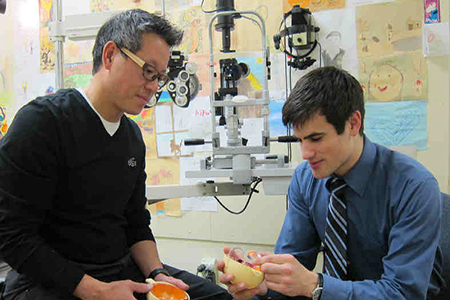So you know you have an artistic or design talent but don’t know if you can make a career out of it. The good news is that a major and career in the arts can offer much more than you may have realized even if you prefer designing or working with computers to painting or creating a sculpture. An art institution or specialized art program might be the logical next step for you if you have an eagerness to create and a strong commitment to seeing your vision through.
As the globe becomes more connected and different forms of visual media become more intertwined the arts are keeping pace with the rest of the culture … and sometimes they even help to change culture! More than ever creative collaboration is a key part of the arts world. Video product and graphic design computer animation drawing painting and 3-D art-making; these are some of the ways you might be able to express who you are—and make a living as well!
WHAT TO STUDY
In the 21st century there is a range of opportunities to study in the fine arts. There are programs in the classical fine arts—drawing painting sculpture and performance—as well as applied art programs like design illustration comic art graphic design film-making animation and urban design or architecture. Many programs also include a foundational year to learn a lot of different art-making processes.
Students might be interested in producing art professionally becoming art instructors working in a museum or bringing their creative skills to a new environment. Judith Aaron, Vice President for Enrollment Management at Pratt Institute, has noticed a continually increasing trend toward students interested in fashion design and industrial design including jewelry and furniture-making. Part of the reason is that more students “are exposed to design on television” and on the Internet before they even enroll she says. “Now they’re much more sophisticated.”
Other growing trends are computer-based especially careers in digital art animation and interactive media. Sandy Britton, Director of Enrollment Management at the Kendall College of Art and Design of Ferris State University said that she has noticed a growing need for artists who can bring creative thinking and imaginative problem-solving skills to collaborative teams in non-art-related fields such as the sciences businesses and nonprofit organizations.
Linda Schwab, Director of Admissions at Watkins School of Art, points out an increasing trend in technology-related art. Yet there has also been growth in young people returning to hand-printed letter-pressed and industrially manufactured forms of illustration and design: a nod to vintage design and art-making techniques developed before the advent of computers.
STARTING OUT
If the fine arts and design fields seem like a great fit for you the first step is to check out different types of programs of study. Research is important. Ask your guidance counselor for good recommendations of schools and then check out different brochures catalogs and websites to see what programs might interest you the most. Visit schools if you can. It’s also a good idea to talk to alumni to get their opinion on professors whether they felt supported by their advisers and what career paths they followed. Carolina Wheat, Director of Admissions at Parsons The New School of Design says advisers and faculty work to cultivate an environment at Parsons “where students will flourish creatively and intellectually becoming artists and designers whose ideas and products will improve the world in which we all live.” Think about whether you feel there is a good chance this will happen at the school of your choice.
Britton says its admissions team works with prospective students to answer three questions about their art: “What am I good at doing? What am I inspired to commit to? What does the world need now?”
“By exploring these three elements,” she explains. “We get students to really think about who they are their goals and [whether they’ll] make a living doing what they love.”
GETTING IN
First of all preparing to apply to an art school (and an art career beyond that!) takes a lot of practice. Maybe more than you might think. Competition is stiff so a strong portfolio is vital.
Maggy Cuesta, Dean of Visual Arts at the New World School of the Arts (NWSA) at Miami-Dade College in Florida says that typically the admissions department requires a minimum of 20 pieces or images of pieces in an applicant’s portfolio. Many schools look for a wide range of skills in different mediums such as drawing painting photography or sculpture. Others look for a special skill in a particular area or a demonstration of strong meaningful themes expressed in a student’s art. “Sometimes … we really see some special quality [in a student’s portfolio],” Cuesta says. “Their skills might not be developed but their concepts are strong.”
National Portfolio Days help students get early evaluations for their artistic portfolios. These are events where art institutions send representatives to review portfolios and give students feedback on their work including what they can improve. “We love to see sophomores and juniors as well as seniors [at National Portfolio Days],” says Schwab. “Seeing these students while they are still developing their style allows us to give them feedback and follow their progress over two or three years.”
But admissions deans and directors point out that academic achievement and teacher recommendations are in most cases a key part of an application. “What a teacher says about the way a student learns works with challenges and interacts with their peers is wonderfully insightful,” says Wheat.
Aaron adds that Pratt puts high emphasis on academics for the reason that good academic practices help committed students tackle the high amount of work required in an intensive art program. “The students who are really talented and have wonderful portfolios—but never worked—are less likely to do well here” she says. Schwab says that she looks at academics as well to see if students can think through many different concepts that are found in different liberal arts subject areas.
If your grades aren’t quite as high as you’d like but you want to commit to working hard in an art program you might be glad to hear that some schools do accept students solely based on the quality of their portfolio. Cuesta of NWSA says its admissions team won’t deny admission to a student with excellent talent based on his or her grades.
B.C. (BEFORE COLLEGE)
Some of the other things you can do to prepare for entering a fine arts/design school happen outside the classroom. A pre-college program can often give you a taste of the kind of work expected in a more rigorous art program as well as give you great experience in refining your skills and adding to your portfolio.
Aaron says she highly recommends a summer pre-college program at a high-level institution not just as a high school résumé builder “but also to figure out whether it’s really what they want to do.” An art school education is quite rigorous and requires a lot of hard work she adds. It’s good to take that kind of commitment for a “test drive” by trying a pre-college program first.
Some other tips admissions experts give: “Experiment with all mediums; try different things; keep a sketchbook” says Schwab. “Read. Imagination and ideas come from everywhere. Go to museums and gallery openings. Think about why you like something and why you don’t. You don’t have to like everything. Art is supposed to challenge you and make you a little uncomfortable.”
Be inquisitive. Try to think creatively in other areas of your studies right now even if you’re extremely committed to pursuing fine arts or design. Britton says contemporary culture is waking up to the “importance of design thinking and creative problem-solving.” The ability to soak up learning from many perspectives is crucial to later success: “In collaborative environments all over the world employers are looking for people who understand the design process can apply it to real-life challenges and know how to communicate their ideas to the team,” she says.
It’s really the drive to create living within you—and whether you choose to relentlessly pursue that drive—that will ultimately determine your success in a fine arts or design career!
Jill Hicks is a writer and editor currently living in Missouri.



